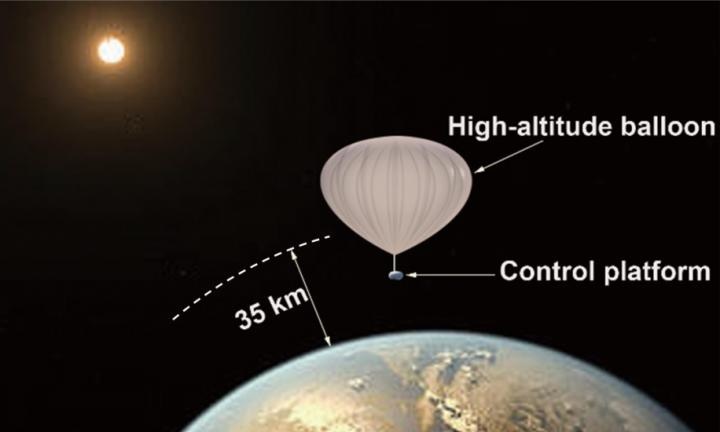Mar 13 2019
Perovskite solar cells (PSCs), with constant optimization for efficiency and stability, have slowly made their way to practical uses. Hence, PSCs may find specialized application in space, where moisture and oxygen (two important stressors for the stability) are hardly present.
 This is a representative schematic of the high-altitude balloon in near space (perovskite solar cells were fixed on the control platform). (Image credit: Science China Press)
This is a representative schematic of the high-altitude balloon in near space (perovskite solar cells were fixed on the control platform). (Image credit: Science China Press)
The scientists at Peking University in China have reported in their new study, published in Science China Physics, Mechanics & Astronomy, led by Dr Rui Zhu and Prof. Qihuang Gong together with Prof. Guoning Xu (Academy of Opto-Electronics, CAS) and Prof. Wei Huang (Northwestern Polytechnical University), about the stability of PSCs in near space.
The metal halide perovskite materials show high performance in photovoltaics owing to their very good optoelectronic properties. PSCs have exhibited high power-per-weight, outstanding efficiency, and excellent radiation resistance and are considered to have the potential to be applied to develop new-generation energy technology for space application. Although a considerable challenge to the stability of the devices would be imposed by the extreme space environment, and the use of PSCs in space has hardly been investigated.
Scientists have attempted to study the stability of large-area PSCs (active area of 1.00 cm2) in near space. The devices were fastened on the high-altitude balloon rising from the ground to near space at an altitude of 35 km in Inner Mongolian Area, China.
The near-space atmosphere at 35 km has a small amount of moisture and ozone, which results in the AM0 solar spectrum having the light intensity of 136.7 mW/cm2. This atmosphere also possesses more high-energy particles and radiation (like electrons, neutrons, and gamma rays), produced by the solar flares and galactic cosmic rays. The devices were developed as TiO2 mesoporous structure based on two often-reported mixed-cation perovskites, namely FA0.9Cs0.1PbI3 and FA0.81MA0.10Cs0.04PbI2.55Br0.40. Besides, various types of perovskite photoactive absorbers with and without ultraviolet filter were researched. Eventually, the device based on FA0.81MA0.10Cs0.04PbI2.55Br0.40 has retained 95.19% of its initial power conversion efficiency under AM0 illumination condition.
It has been predicted by the scientists that this study would play a major role in the future stability analysis of PSCs. This study has opened its doors for PSCs in the future space application. Dr Rui Zhu and his coworkers have been constantly working on the practical application of PSCs in space.
This study was supported by the 973 Program of China (Grant No. 2015CB932203), the National Natural Science Foundation of China (Grant Nos 61722501 and 61377025), the Beijing Natural Science Foundation (Grant No. 4164106), the Scientific Experimental System in Near Space of Chinese Academy of Sciences (Grant No. XDA17000000), and the General Financial Grant from the China Postdoctoral Science Foundation (Grant No. 2017M620519).